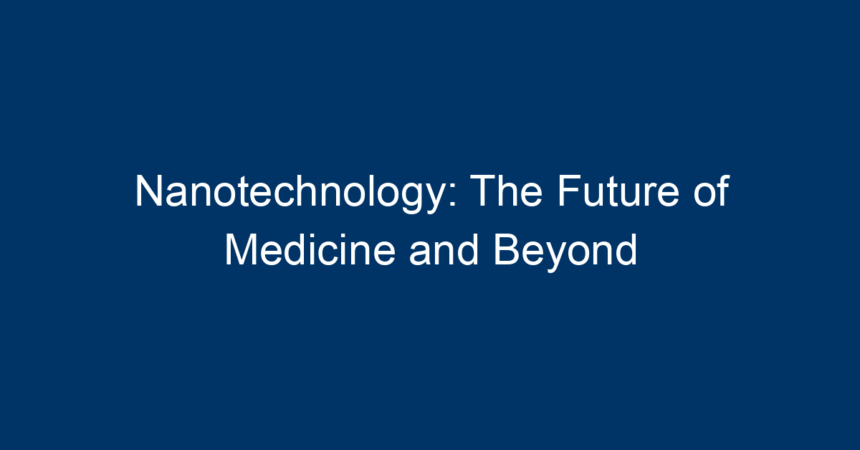Introduction
In the rapidly evolving landscape of science and technology, nanotechnology stands out as a groundbreaking field with the potential to revolutionize various sectors, especially medicine. This innovative science operates at a molecular scale, typically ranging from 1 to 100 nanometers. Within this minuscule realm, unique properties and behaviors emerge, opening up new avenues for development in drug delivery, diagnostics, and even regenerative medicine. In this article, we will explore how nanotechnology is transforming medicine and extending its influence into other domains, paving the way for a healthier, more advanced future.
Understanding Nanotechnology
What is Nanotechnology?
Nanotechnology refers to the manipulation of matter on an atomic or molecular scale to create materials and devices with novel properties. By engineering substances at the nanoscale, researchers can harness unique physical, chemical, and biological characteristics that differ significantly from their larger-scale counterparts. This transformative capability is why nanotechnology is often described as a "game-changer" across multiple disciplines.
The Science Behind Nanotechnology
At the heart of nanotechnology is the concept of size. As materials shrink to the nanoscale, they exhibit enhanced surface area, improved electrical conductivity, and unique optical properties. For instance, gold nanoparticles exhibit different colors depending on their size and shape, making them valuable in various applications, including biomedical imaging and photothermal therapy. Understanding these properties allows scientists and engineers to tailor materials for specific uses, leading to remarkable innovations.
The Role of Nanotechnology in Medicine
Drug Delivery Systems
One of the most promising applications of nanotechnology is in targeted drug delivery. Traditional medication often lacks specificity, affecting healthy tissues alongside diseased areas. Nanotechnology aims to solve this problem by using nanoparticles as vehicles to transport drugs directly to targeted cells. These nanoparticles can be designed to release their payload in response to specific stimuli, such as changes in pH or temperature, ensuring that the medication only acts where it is most needed.
For example, liposomes and dendrimers are two types of nanoparticles currently being researched for their ability to enhance the efficacy of chemotherapy drugs, reducing side effects and improving treatment outcomes for cancer patients.
Diagnostic Advancements
In addition to drug delivery, nanotechnology significantly enhances diagnostic techniques. Nanoscale materials can improve imaging techniques, allowing healthcare providers to detect diseases at much earlier stages. For instance, gold nanoparticles can be conjugated with antibodies to target specific cancer cells, providing high-contrast images during diagnostic scans.
Moreover, nanobiosensors, made from nanomaterials, can detect biomolecules at extremely low concentrations, enabling quicker and more accurate diagnoses of infectious diseases and other health conditions.
Regenerative Medicine
Another exciting frontier for nanotechnology in medicine is regenerative medicine. This field focuses on repairing, replacing, or regenerating damaged tissues and organs. Nanomaterials can create scaffolds that mimic the extracellular matrix, enabling stem cells to grow and differentiate into specific tissue types. Research is underway to explore the use of nanotechnology for engineering organs for transplantation, potentially alleviating organ shortages.
Beyond Medicine: Other Applications of Nanotechnology
Environmental Solutions
Nanotechnology isn’t limited to medicine; it also holds transformative potential for environmental applications. Nanomaterials can be employed in water purification processes, improving the removal of contaminants at a molecular level. For instance, nanoparticles can catalyze reactions that break down harmful substances, making water safe for consumption.
Energy Efficiency
In the field of energy, nanotechnology is making strides toward enhancing energy efficiency and the development of sustainable sources. Nanomaterials can improve solar cell efficiency, leading to more effective renewable energy solutions. Additionally, nanotechnology can enhance battery technology, increasing charge capacity and reducing charging times, which is crucial for the proliferation of electric vehicles.
Food Safety
Nanotechnology is also proving beneficial in the food industry. It can be utilized to create better packaging materials that enhance food preservation and safety. Nanosensors can detect spoilage or contamination in food products, contributing to safer food supply chains and improved consumer health.
Challenges and Ethical Considerations
While the promise of nanotechnology is immense, it is not without challenges. Concerns regarding the safety and environmental impact of nanomaterials remain a significant barrier to widespread acceptance. Research is ongoing to understand the long-term effects of nanoparticles on human health and ecosystems.
Regulatory Frameworks
As nanotechnology continues to evolve, establishing regulatory frameworks will be essential. Policymakers need to work closely with scientists and industry leaders to create guidelines that ensure safety while fostering innovation. Striking the right balance between regulation and freedom to innovate is critical for the future of nanotechnology.
Public Perception
Another challenge is public perception. Misinformation and fear surrounding nanotechnology can hinder its advancement. Engaging the public through education and transparency is vital to promote understanding and acceptance of nanotechnology’s benefits.
Conclusion: Embracing the Future of Nanotechnology
As we explore the vast potential of nanotechnology, it becomes clear that its implications stretch far beyond medicine. The ability to manipulate materials at the nanoscale offers unprecedented opportunities across various fields, revolutionizing sectors such as environmental science, energy, and food safety.
Actionable Insights
-
Stay Informed: As advancements in nanotechnology continue to evolve, staying informed about the latest research and applications is essential. Follow reputable sources and scientific publications to keep abreast of developments.
-
Advocate for Responsible Research: Support and advocate for responsible research practices that prioritize safety and ethical considerations in nanotechnology applications.
- Engage with the Community: Participate in discussions, webinars, and workshops that promote awareness and understanding of nanotechnology to demystify it for the wider public.
In conclusion, nanotechnology is not merely a scientific novelty; it is a harbinger of change in how we approach health, the environment, and technology itself. Embracing and responsibly advancing this field could lead to a brighter, healthier future for all. With continued research, collaborative efforts, and public engagement, the future of nanotechnology looks promising, heralding a new era of innovation and possibility.




